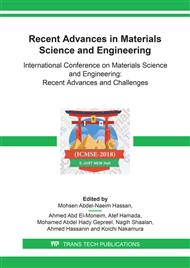[1]
F. Klocke et al., Abrasive machining of advanced aerospace alloys and composites, CIRP Ann. - Manuf. Technol., vol. 64, no. 2, (2015) p.581–604.
DOI: 10.1016/j.cirp.2015.05.004
Google Scholar
[2]
F. Feucht, J. Ketelaer, A. Wolff, M. Mori, and M. Fujishima, Latest machining technologies of hard-to-cut materials by ultrasonic machine tool, Procedia CIRP, vol. 14, (2014) p.148–152.
DOI: 10.1016/j.procir.2014.03.040
Google Scholar
[3]
K. Ding, Y. Fu, H. Su, X. Gong, and K. Wu, Wear of diamond grinding wheel in ultrasonic vibration-assisted grinding of silicon carbide, Int. J. Adv. Manuf. Technol., vol. 71, no. 9–12, (2014) p.1929–(1938).
DOI: 10.1007/s00170-014-5625-x
Google Scholar
[4]
J. Y. Shen, J. Q. Wang, B. Jiang, and X. P. Xu, Study on wear of diamond wheel in ultrasonic vibration-assisted grinding ceramic, Wear, vol. 333, (2015) p.788–793.
DOI: 10.1016/j.wear.2015.02.047
Google Scholar
[5]
K. M. Li and S. L. Wang, Effect of tool wear in ultrasonic vibration-assisted micro-milling, Proc. Inst. Mech. Eng. Part B J. Eng. Manuf., vol. 228, no. 6, (2014) p.847–855.
Google Scholar
[6]
J. Janghorbanian, M. R. Razfar, and M. M. A. Zarchi, Effect of cutting speed on tool life in ultrasonic-assisted milling process, Proc. Inst. Mech. Eng. Part B J. Eng. Manuf., vol. 227, no. 8, (2013) p.1157–1164.
DOI: 10.1177/0954405413483722
Google Scholar
[7]
H. Gong, F. Z. Fang, and X. T. Hu, Kinematic view of tool life in rotary ultrasonic side milling of hard and brittle materials, Int. J. Mach. Tools Manuf., vol. 50, no. 3, (2010) p.303–307.
DOI: 10.1016/j.ijmachtools.2009.12.006
Google Scholar
[8]
F. N. H. Abd Halim, H. Ascroft, and S. Barnes, Analysis of tool wear , cutting force , surface roughness and machining temperature during finishing operation of ultrasonic assisted milling ( UAM ) of Carbon Fibre Reinforced Plastic ( CFRP )," Procedia Eng., vol. 184, (2017).
DOI: 10.1016/j.proeng.2017.04.084
Google Scholar
[9]
E. Bertsche, K. Ehmann, and K. Malukhin, Ultrasonic slot machining of a silicon carbide matrix composite, (2013) p.1119–1134.
DOI: 10.1007/s00170-012-4394-7
Google Scholar
[10]
N. F. H. Abd-Halim, H. Ascroft, and S. Barnes, Machinability study of ultrasonic assisted machining (UAM) of Carbon Fibre Reinforced Plastic (CFRP) with multifaceted tool, Procedia CIRP, vol. 46, (2016) p.488–491.
DOI: 10.1016/j.procir.2016.04.041
Google Scholar
[11]
A. N. Dahnel, H. Ascroft, and S. Barnes, The effect of varying cutting speeds on tool wear during conventional and Ultrasonic Assisted Drilling ( UAD ) of Carbon Fibre Composite ( CFC ) and titanium alloy stacks ., in 7th HPC 2016 – CIRP Conference on High Performance Cutting, vol. 46, (2016).
DOI: 10.1016/j.procir.2016.04.044
Google Scholar


